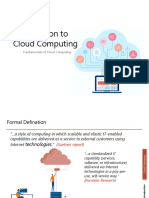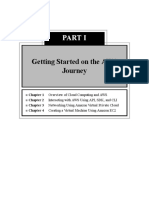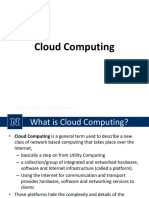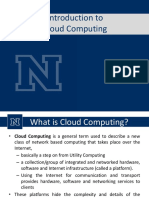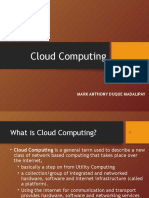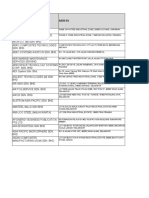Understanding Cloud Computing
What is Cloud Computing?
Cloud computing refers to delivering computing services over the internet (the
”cloud”). Rather than owning physical servers or data centers, users can rent
computing resources from cloud providers such as Amazon Web Services
(AWS), Microsoft Azure, or Google Cloud.
Why Use the Cloud?
• Cost Efficiency: You only pay for what you use.
• Scalability: Easily scale resources up or down as needed.
• Flexibility: Access services from any device with an internet connection.
• Maintenance: Cloud providers handle updates, security, and hardware.
Key Concepts in Cloud Computing
1. Cloud Service Models
Cloud services can be categorized into three main models:
1. Infrastructure as a Service (IaaS): IaaS offers virtualized computing
resources over the internet. Users can rent virtual machines, storage, and
networks.
Example: Amazon EC2, Google Compute Engine
2. Platform as a Service (PaaS): PaaS offers a platform allowing cus-
tomers to develop, run, and manage applications without worrying about
underlying infrastructure.
Example: Google App Engine, Microsoft Azure App Services
3. Software as a Service (SaaS): SaaS provides software applications
over the internet on a subscription basis. The software is hosted by the
provider, and users access it via a web browser.
Example: Google Workspace, Microsoft 365, Salesforce
1
�2. Cloud Deployment Models
These describe how cloud infrastructure is set up and who has access to it:
1. Public Cloud: Resources are shared by many customers, and anyone can
use them.
Example: AWS, Google Cloud
2. Private Cloud: Dedicated to a single organization for greater control
and security.
Example: An organization’s internal cloud infrastructure.
3. Hybrid Cloud: Combines public and private clouds, allowing data to be
shared between them.
Example: A company storing sensitive data in a private cloud but using
a public cloud for scalability.
4. Community Cloud: Shared by organizations with common goals or
regulatory requirements.
Example: A group of hospitals using a shared cloud for healthcare data.
3. Key Cloud Computing Characteristics
1. On-demand Self-Service: Users can provision resources without human
intervention from the provider.
2. Broad Network Access: Cloud services are available over the network
and can be accessed from various devices.
3. Resource Pooling: Cloud providers pool resources to serve multiple
customers dynamically.
4. Rapid Elasticity: Resources can scale quickly based on demand.
5. Measured Service: Cloud services are metered, and customers pay for
what they use (e.g., storage, compute time).
4. Cloud Computing Examples
• Google Drive, Dropbox: Cloud-based file storage services.
• Netflix, Spotify: Streaming services relying on the cloud for delivering
content.
• Amazon Web Services (AWS): A comprehensive cloud platform pro-
viding IaaS, PaaS, and SaaS.
2
�5. Cloud Security
Key considerations for cloud security:
• Data Encryption: Ensures data is secure when stored or transmitted.
• Access Control: Allows fine-grained control over who can access cloud
resources.
• Compliance: Cloud providers meet industry standards (like HIPAA,
GDPR) for security.
6. Cloud Virtualization
Virtualization is the technology that enables cloud computing by creating
virtual versions of physical hardware. This allows for resource sharing between
multiple users.
• Virtual Machines (VMs): Software-based computers running on phys-
ical hardware. VMs allow multiple operating systems to run on a single
machine.
• Containers: Lightweight alternatives to VMs for packaging applications
and their dependencies, ensuring that they work seamlessly across different
computing environments.
7. Docker and Kubernetes in Cloud Computing
Docker and Kubernetes are essential technologies for containerization and
orchestration in cloud environments.
• Docker: Docker allows developers to package applications and their de-
pendencies into containers. These containers are portable and can be eas-
ily deployed across any environment (development, testing, production).
Docker simplifies the development and deployment process by ensuring
consistency across different platforms.
• Kubernetes: Kubernetes is a container orchestration tool used to man-
age containers in a distributed environment. It automates deployment,
scaling, and operation of containerized applications. Kubernetes helps
in managing clusters of containers, handling issues such as scaling, load
balancing, and fault tolerance.
• Benefits of Using Docker and Kubernetes in Cloud: Together,
Docker and Kubernetes allow applications to be more scalable, portable,
and resilient. Kubernetes provides automation for managing Docker con-
tainers, ensuring high availability and easy scaling based on demand.
3
�8. Advantages and Disadvantages of Cloud Computing
Advantages
• Cost Efficiency: Reduces the need for large capital investments in in-
frastructure and hardware. Pay only for what you use.
• Scalability and Flexibility: Easily scale resources based on demand
and access services from anywhere.
• Maintenance-Free: Cloud providers manage updates, security patches,
and hardware.
• Disaster Recovery: Backup solutions and automatic failover features
help ensure business continuity.
• Collaboration: Facilitates easier collaboration and data sharing among
remote teams.
• Security: Cloud providers invest in robust security measures like encryp-
tion, access control, and regular audits.
Disadvantages
• Dependence on Internet Connectivity: Cloud computing relies on
internet access, so connectivity issues can affect service availability.
• Security and Privacy Concerns: Storing data on third-party servers
raises concerns about unauthorized access and data breaches.
• Downtime and Service Interruptions: Although cloud providers aim
for high uptime, outages can still occur, potentially disrupting business
operations.
• Limited Control: Users have less control over the infrastructure and
services provided by the cloud vendor.
• Hidden Costs: Additional costs can arise from data transfer fees, scaling,
and unused resources.
• Vendor Lock-In: Migrating services between cloud providers can be
complex and costly.
Final Thoughts
Cloud computing offers a flexible, cost-effective, and scalable way to use technol-
ogy. By understanding key models (IaaS, PaaS, SaaS), deployment types (pub-
lic, private, hybrid), and key characteristics (scalability, elasticity, on-demand
service), you can better appreciate the full potential of the cloud. Technologies
like Docker and Kubernetes enable efficient containerization and orchestration
4
�of applications, while virtualization makes resource sharing and scaling possi-
ble. Despite the numerous benefits, it is important to consider the potential
downsides, such as security risks, vendor lock-in, and reliance on internet con-
nectivity.
AWS Services in Real-World Scenarios
Question: Can you give an example of AWS services in real-world scenarios?
Answer: Amazon Web Services (AWS) offers cloud computing solutions
across different models such as IaaS, PaaS, and SaaS. Below are real-world
examples illustrating how various AWS services are used effectively:
1. Infrastructure as a Service (IaaS)
Compute Services
• Amazon EC2 (Elastic Compute Cloud): A scalable virtual machine
(VM) service that allows users to deploy and manage cloud-based servers.
EC2 instances can be customized based on CPU, memory, and storage
needs.
Example: An e-commerce company hosts its website on an EC2 instance,
ensuring that resources scale during high-traffic shopping events like Black Fri-
day.
Storage Services
• Amazon S3 (Simple Storage Service): An object storage service that
enables users to store and retrieve files, images, backups, and application
data with high durability and scalability.
Example: A video streaming service stores movie files in Amazon S3 and
delivers them efficiently to users via AWS CloudFront.
Networking Services
• Amazon VPC (Virtual Private Cloud): Provides an isolated, secure
network environment for running cloud applications.
Example: A banking institution deploys its financial services within a VPC
to enhance security and compliance.
—
5
�2. Platform as a Service (PaaS)
Application Deployment
• AWS Elastic Beanstalk: A fully managed service that automatically
deploys, scales, and monitors applications in multiple programming lan-
guages.
Example: A startup company uses Elastic Beanstalk to launch a Python/Django
web app without worrying about server configurations.
Database Management
• Amazon RDS (Relational Database Service): A managed database
service that supports multiple database engines like MySQL, PostgreSQL,
and SQL Server.
Example: A social media platform stores user profiles and messages using
Amazon RDS for PostgreSQL, ensuring automated backups and maintenance.
Serverless Computing
• AWS Lambda: A serverless compute service that runs code in response
to events without requiring users to provision or manage servers.
Example: An image-sharing app triggers AWS Lambda functions to resize
images automatically when users upload them.
—
3. Software as a Service (SaaS)
Remote Work Solutions
• Amazon WorkSpaces: A virtual desktop infrastructure (VDI) that al-
lows employees to access cloud-based desktops securely.
Example: A multinational company enables remote work by providing em-
ployees with cloud-based desktops through Amazon WorkSpaces.
Customer Support and Communication
• Amazon Connect: A cloud-based contact center service for handling
customer support with automated call routing.
Example: An airline company uses Amazon Connect to set up an AI-
powered helpline for booking inquiries.
6
�Video Conferencing
• Amazon Chime: A secure video conferencing and messaging service for
businesses.
Example: A software development team uses Amazon Chime for daily
stand-up meetings and project discussions.
—
4. Specialized AWS Services
AI and Machine Learning
• Amazon Rekognition: An image and facial recognition service that
detects objects, faces, and scenes in photos and videos.
Example: A security company uses Rekognition to verify the identity of
employees entering a building.
• Amazon Polly: A text-to-speech service that converts written content
into natural-sounding speech.
Example: A news website integrates Polly to provide an audio version of
its articles.
Security Compliance
• AWS IAM (Identity and Access Management): Manages user ac-
cess and permissions within AWS accounts.
Example: A healthcare organization uses IAM to enforce multi-factor au-
thentication for data protection.
• AWS Shield: Provides DDoS protection to safeguard applications against
cyber threats.
Example: An online gaming platform uses AWS Shield to prevent dis-
tributed denial-of-service attacks.
—
Final Summary
• IaaS: EC2 (Compute), S3 (Storage), VPC (Networking) – Enables scal-
able IT infrastructure.
• PaaS: Elastic Beanstalk (App Deployment), RDS (Managed Databases),
Lambda (Serverless) – Simplifies app and database management.
7
� • SaaS: WorkSpaces (Remote Desktops), Amazon Connect (Call Centers),
Amazon Chime (Video Conferencing) – Delivers fully managed business
applications.
• Specialized Services: AI (Rekognition, Polly), Security (IAM, Shield)
– Enhances intelligence and cybersecurity.
1 Introduction
Amazon Web Services (AWS) is a comprehensive cloud computing platform of-
fering scalable and cost-effective solutions. It provides various services, includ-
ing computing, storage, databases, networking, and security, to help businesses
deploy and manage applications efficiently.
2 Elastic Compute Cloud (EC2)
EC2 provides resizable virtual servers in the cloud. It allows users to launch
and manage virtual machines (instances) with different operating systems.
2.1 Real-Life Example
A startup wants to host a web application. Instead of buying physical servers,
they launch an EC2 instance, configure it with their application, and scale it up
when traffic increases.
3 Simple Storage Service (S3)
S3 is an object storage service designed for scalability, security, and high avail-
ability. It stores any type of data and provides features such as versioning and
encryption.
3.1 Real-Life Example
A media company uses S3 to store and distribute high-resolution images and
videos. Users worldwide can access the content via CDN integration.
4 DynamoDB
DynamoDB is a fully managed NoSQL database that provides high performance
with automatic scaling.
4.1 Real-Life Example
An e-commerce platform uses DynamoDB to store product catalog information,
ensuring low-latency access for millions of users.
8
�5 REST APIs on AWS
REST APIs can be deployed on AWS using API Gateway, Lambda, or EC2.
5.1 Real-Life Example
A mobile app needs to fetch weather data. API Gateway routes requests to a
Lambda function, which processes data from a weather database and returns
JSON responses.
6 AWS Lambda
AWS Lambda is a serverless compute service that runs code in response to
events.
6.1 Real-Life Example
A company processes uploaded images by triggering a Lambda function when a
new image is stored in an S3 bucket. The function resizes the image and stores
it in another bucket.
7 Docker on AWS
Docker containers can be deployed on AWS using services like ECS (Elastic
Container Service) and EKS (Elastic Kubernetes Service).
7.1 Real-Life Example
A team builds a microservices-based application where each service runs in a
separate Docker container. AWS ECS manages the containers efficiently.
8 CI/CD Pipelines
AWS provides CI/CD tools like CodePipeline, CodeBuild, and CodeDeploy for
automated software deployment.
8.1 Real-Life Example
A software company automates its deployment process using CodePipeline.
Each code commit triggers a build and deployment to production automati-
cally.
9
�9 Amazon CloudWatch
CloudWatch provides monitoring and observability for AWS resources. It col-
lects and visualizes logs, metrics, and events.
9.1 Real-Life Example
A DevOps team sets up CloudWatch alerts to monitor EC2 instance CPU usage.
If CPU usage exceeds 80% for 5 minutes, an alert notifies the team.
10 Other Important AWS Services
• RDS (Relational Database Service) - Managed SQL databases like
MySQL, PostgreSQL, and SQL Server.
• IAM (Identity and Access Management) - Security and access con-
trol for AWS resources.
• CloudFront - Content delivery network (CDN) for fast and secure content
distribution.
• SQS (Simple Queue Service) - Message queuing service for decoupling
components.
11 Conclusion
AWS offers a wide range of cloud services that help businesses scale efficiently.
Understanding services like EC2, S3, Lambda, and DynamoDB is crucial for
cloud professionals. over
Course Introduction and Café Business Case
Objective: Understand the course structure and familiarize yourself with the
café business scenario.
• Review course objectives and expectations.
• Explore the café’s business requirements and how cloud solutions can ad-
dress them.
12 Introduction to Developing on AWS
Objective: Gain foundational knowledge of cloud computing and AWS ser-
vices.
• Learn about the systems development lifecycle in AWS.
10
� • Explore AWS SDKs and their role in application development.
• Understand the use of AWS Cloud9 for writing, running, and debugging
code.
Outcome: A solid understanding of cloud development principles and tools.
13 Developing Storage Solutions with Amazon
S3
Objective: Implement storage solutions using Amazon S3.
• Create and configure Amazon S3 buckets.
• Manage data storage and retrieval using the AWS SDK.
• Implement data protection and access management strategies.
Outcome: Effective management of storage solutions for the café website.
14 Securing Access to Cloud Resources
Objective: Implement security measures using AWS Identity and Access Man-
agement (IAM).
• Learn about the shared responsibility model.
• Configure IAM users, groups, and roles for secure access control.
Outcome: Secure access management for AWS resources.
15 Developing Flexible NoSQL Solutions with
Amazon DynamoDB
Objective: Implement NoSQL database solutions using Amazon DynamoDB.
• Understand DynamoDB key concepts and data modeling.
• Perform basic operations and manage throughput capacity.
Outcome: A scalable NoSQL database solution for the café website.
11
�16 Developing REST APIs with Amazon API
Gateway
Objective: Create and manage RESTful APIs using Amazon API Gateway.
• Design, deploy, and secure APIs.
• Integrate APIs with AWS Lambda functions for serverless execution.
Outcome: Functional APIs to handle client requests for the café website.
17 Developing Event-Driven Serverless Solutions
with AWS Lambda
Objective: Implement serverless computing solutions using AWS Lambda.
• Author and configure Lambda functions.
• Set up event sources to trigger functions.
Outcome: Event-driven functionalities for the café website.
18 Introducing Containers and Container Ser-
vices
Objective: Explore containerization concepts and AWS container services.
• Understand the use of Docker containers.
• Learn about AWS container services like Amazon ECS and EKS.
Outcome: Knowledge of deploying applications using containers.
19 Caching Information for Scalability
Objective: Implement caching strategies to enhance application performance.
• Learn about caching mechanisms using Amazon CloudFront and Elasti-
Cache.
• Implement caching strategies to reduce latency.
Outcome: Improved scalability and performance of the café website.
12
�20 Deploying Applications on AWS
Objective: Learn deployment strategies and tools for AWS applications.
• Explore CI/CD pipelines using AWS Code Services.
• Deploy applications using AWS Elastic Beanstalk and CloudFormation.
Outcome: Efficient deployment and management of the café website.
21 Conclusion
By completing these tasks, students gain practical experience in developing, de-
ploying, and managing cloud-based applications using AWS services, preparing
them for roles in cloud development and operations.
13


